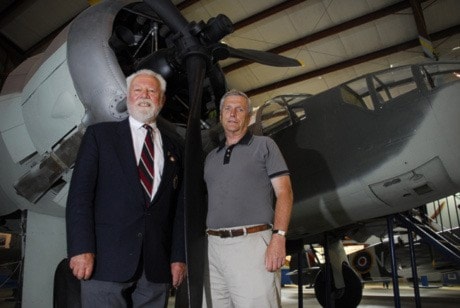By Don Descoteau
News Review staff
Ramsay Murray can’t say he was involved in the construction of the former Patricia Bay Airfield.
He’s no less a fan of the facility, which began life as a Royal Air Force training station in 1939 and served as the main air base on the Pacific Coast during the Second World War before becoming the Capital Region’s primary land-based air transportation hub.
Murray, 86, has been on a mission in recent years. He wanted to see Pat Bay and more than 80 other wartime airfields constructed under the British Commonwealth Air Training Plan designated as national historic civil engineering sites.
Friday, Sept. 7 he’ll get his wish, as the Canadian Society for Civil Engineering – Murray is a member of its national history committee – unveils a plaque at the B.C. Aviation Museum commemorating the military beginnings of what is now know as Victoria International Airport.
Completed just in time to begin training air personnel for wartime duty, and to serve as an operational patrol unit watching for submarines off Vancouver Island and B.C.’s North Coast, Pat Bay became the country’s third-largest military airfield. By the war’s end, roughly 7,000 personnel trained or were stationed there.
The south island project, planned well before war was declared, was a predecessor for a massive blitz that saw 88 airfields and ancillary buildings constructed in an 18-month period in the early stages of the Second World War.
“That was quite a monumental piece of work to execute in that time,” Murray says, noting that $2 billion was spent on such construction projects in 1940 alone. Canada had the lion’s share of those, but airfields were also built in Australia, New Zealand and South Africa, among other countries in the former British Empire.
“It really was quite an effort, and that is what we are trying to recognize. It’s an important part of Canadian history.”
A time of change for region
In the mid-1930s, when the powers-that-be in Victoria were looking for ways to create jobs and expand their business horizons, the idea of building an airport was floated.
The Lansdowne civilian airfield, on the current site of that middle school’s playing fields, had been shut down in 1933 after four years in operation and some proponents wanted to find a similarly close-to-town location. But before a site could be agreed upon, the Canadian military took over the discussion.
“They wanted something in the Pacific, with tensions growing,” says B.C. Aviation Museum librarian Doug Rollins. “The closest place they could find that suited their needs of both open land and a harbour was at Pat Bay.”
Especially with the outbreak of war in the Pacific, the site became very strategic, both as a training and patrol base, and a staging area for aircraft carrying on to Alaska and Russia.
In fact, very few civilian aircraft were allowed on the runways, Rollins says, the exception being the odd Trans-Canada Airlines plane.
The Pat Bay facility was unique for its combination as a land and maritime air base, unlike Vancouver, where they were separate.
Not only was its location handy as a base for patrolling the waters off Vancouver Island, the seaplanes could service up-Island communities, many of which had little to no infrastructure.
Engineer celebrates the past
While Murray’s time in the Capital Region didn’t coincide with the construction of the Pat Bay airfield, he was involved in such projects elsewhere.
Having joined the RAF’s airfield construction branch in 1945 upon graduating with an engineering degree from Glasgow University in Scotland, he helped develop post-war airfields around the Commonwealth.
Now 86 and retired in Victoria after spending decades building and designing bridges and other engineered structures in civic and private practice, Murray has turned his hand to remembering the past.
He and fellow society volunteers set out to put as many of commemorative plaques as they could on significant airfields built for the Commonwealth air plan.
Due to the undependable weather in Scotland and England, he said, the whole training scheme was brought to Empire countries Canada, New Zealand and in Africa.
In those three areas alone, 230,000 air crew were trained.
“We feel this is really an outstanding achievement,” Murray says. “(These military airfields) have become the basis of the Canadian air system and frankly, all of them started that way.”
For more on the Canadian Society for Civil Engineering’s history projects, visit history.csce.ca.
